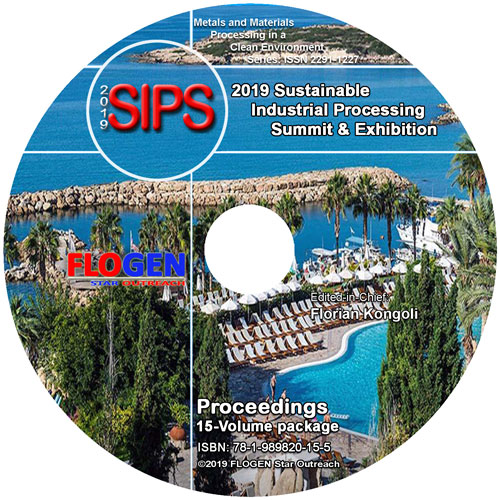2019-Sustainable Industrial Processing Summit
SIPS2019 Volume 8: Usui Intl. Symp. / Advanced Sustainable Iron and Steel Making
| Editors: | F. Kongoli, P. Assis, M.C. Gomez-Marroquin, S. Kitayama, H. Konishi, A. Murao, S. Nomura, H. Ono, H. Saxen, K. Seto, J.I. Tani |
| Publisher: | Flogen Star OUTREACH |
| Publication date: | 20 December 2019 |
| Pages: | 250 pages |
| ISBN: | 978-1-989820-07-0 |
| ISSN: | 2291-1227 (Metals and Materials Processing in a Clean Environment Series) |

CD shopping page
A General Vision for Reduction of Energy Consumption and CO2 Emissions from the Steel Industry
Lauri Holappa1;1PROFESSOR EMERITUS, Espoo, Finland;
Type of Paper: Plenary
Id Paper: 480
Topic: 2
Abstract:
The 2018 IPCC report defined the goal to limit the global warming to 1.5°C by 2050. Accordingly, that would require “rapid and far-reaching transitions in land, energy, industry, buildings, transport, and citiesâ€. The challenges fall on all sectors, but on energy and industry sectors they are most essential and explicitly measurable also. Iron and steel making is an energy-intensive industrial branch. It is playing a significant role in the global energy consumption, as it is largely based on fossil fuel and generates about 7% of overall carbon dioxide emissions. In order to conduct its own share in cutting CO2 emissions, great advancements must be achieved.
This contribution will highlight the present situation of steel industry and show plausible scenarios for the future. Potential methods to decrease CO2 emissions in current processes via improved energy efficiency, increasing recycling and alternative energy sources are surveyed. The role of recycled steel will considerably grow over the next few decades. These factors influence, that the specific energy consumption per ton steel and respective CO2 emissions will strongly decrease. The growth of emissions will be stopped and, in spite of the predicted growth of the steel production from the current 1.8 BT up to 2.5 BT/year, the total emissions from the steel sector can be significantly cut. However, these advancements are not sufficient for the final aim of carbon neutrality. That demands more radical changes in energy sources and systems as well as in iron & steel production technologies. Still today, energy systems are largely based on fossil fuel, but extensive transfer to renewable energy is coming true soon. Corresponding developments are taking place also in steel industry. Several on-going programs and initiatives for low-carbon and carbon-free ironmaking utilizing hydrogen are in progress. These projects as well as trends of future energy systems are surveyed. Finally, a simplified holistic model is shown demonstrating the steel´s contribution in solving the global CO2 emissions problem.
Keywords:
Energy; Iron; Metallurgy; Recycling; Scrap; Steel;References:
[1] V. Masson-Delmotte et al (19 editors)]. Global Warming of 1.5 °C. IPCC report, 2018: Summary for Policymakers. In: https://report.ipcc.ch/sr15/pdf/sr15_spm_final.pdf , 32 pp.[2] https://www.worldsteel.org/steel-by-topic/statistics.html. https://www.worldsteel.org/publications/fact-sheets.html
[3] J-P. L. Birat, Environmental Metallurgy: Continuity or New Discipline? steel research int. 85 (2014) No. 8, 1240-56. [4] M. Ã…hman et al (9 authors). Hydrogen steelmaking for a low-carbon economy. A joint LU-SEI working paper for the HYBRIT project. EESS report no 109, SEI working paper WP 2018-07, Sept. 2018, 28 pp. In: https://www.sei.org/wp-content/uploads/2018/09/hydrogen-steelmaking-for-a-low-carbon-economy.pdf [5] S. Tonomura, Outline of COURSE 50. Energy Procedia Dec.2013, 37:7160-67